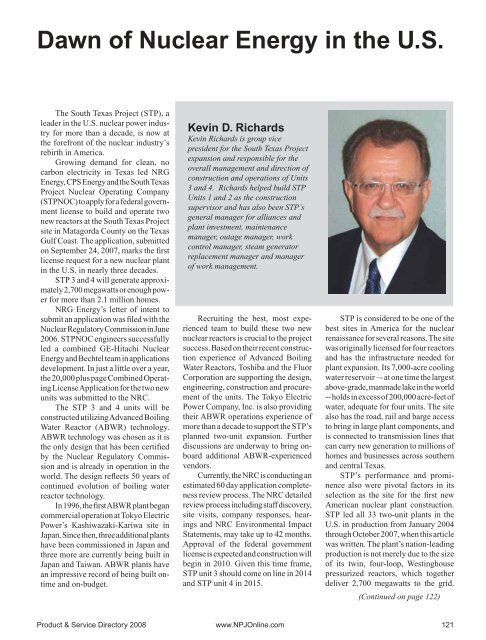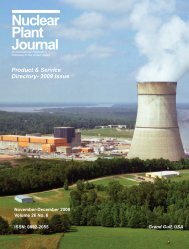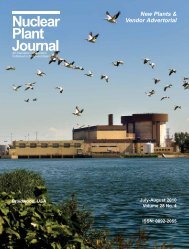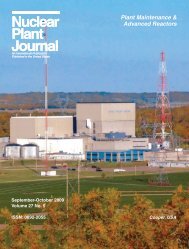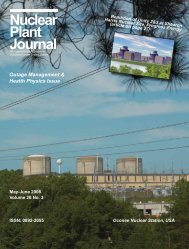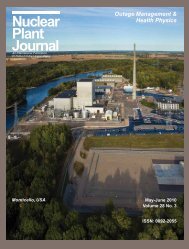Products & Services - Nuclear Plant Journal
Products & Services - Nuclear Plant Journal
Products & Services - Nuclear Plant Journal
Create successful ePaper yourself
Turn your PDF publications into a flip-book with our unique Google optimized e-Paper software.
Dawn of <strong>Nuclear</strong> Energy in the U.S.<br />
The South Texas Project (STP), a<br />
leader in the U.S. nuclear power industry<br />
for more than a decade, is now at<br />
the forefront of the nuclear industry’s<br />
rebirth in America.<br />
Growing demand for clean, no<br />
carbon electricity in Texas led NRG<br />
Energy, CPS Energy and the South Texas<br />
Project <strong>Nuclear</strong> Operating Company<br />
(STPNOC) to apply for a federal government<br />
license to build and operate two<br />
new reactors at the South Texas Project<br />
site in Matagorda County on the Texas<br />
Gulf Coast. The application, submitted<br />
on September 24, 2007, marks the first<br />
license request for a new nuclear plant<br />
in the U.S. in nearly three decades.<br />
STP 3 and 4 will generate approximately<br />
2,700 megawatts or enough power<br />
for more than 2.1 million homes.<br />
NRG Energy’s letter of intent to<br />
submit an application was filed with the<br />
<strong>Nuclear</strong> Regulatory Commission in June<br />
2006. STPNOC engineers successfully<br />
led a combined GE-Hitachi <strong>Nuclear</strong><br />
Energy and Bechtel team in applications<br />
development. In just a little over a year,<br />
the 20,000 plus page Combined Operating<br />
License Application for the two new<br />
units was submitted to the NRC.<br />
The STP 3 and 4 units will be<br />
constructed utilizing Advanced Boiling<br />
Water Reactor (ABWR) technology.<br />
ABWR technology was chosen as it is<br />
the only design that has been certified<br />
by the <strong>Nuclear</strong> Regulatory Commission<br />
and is already in operation in the<br />
world. The design reflects 50 years of<br />
continued evolution of boiling water<br />
reactor technology.<br />
In 1996, the first ABWR plant began<br />
commercial operation at Tokyo Electric<br />
Power’s Kashiwazaki-Kariwa site in<br />
Japan. Since then, three additional plants<br />
have been commissioned in Japan and<br />
three more are currently being built in<br />
Japan and Taiwan. ABWR plants have<br />
an impressive record of being built ontime<br />
and on-budget.<br />
Kevin D. Richards<br />
Kevin Richards is group vice<br />
president for the South Texas Project<br />
expansion and responsible for the<br />
overall management and direction of<br />
construction and operations of Units<br />
3 and 4. Richards helped build STP<br />
Units 1 and 2 as the construction<br />
supervisor and has also been STP’s<br />
general manager for alliances and<br />
plant investment, maintenance<br />
manager, outage manager, work<br />
control manager, steam generator<br />
replacement manager and manager<br />
of work management.<br />
Recruiting the best, most experienced<br />
team to build these two new<br />
nuclear reactors is crucial to the project<br />
success. Based on their recent construction<br />
experience of Advanced Boiling<br />
Water Reactors, Toshiba and the Fluor<br />
Corporation are supporting the design,<br />
engineering, construction and procurement<br />
of the units. The Tokyo Electric<br />
Power Company, Inc. is also providing<br />
their ABWR operations experience of<br />
more than a decade to support the STP’s<br />
planned two-unit expansion. Further<br />
discussions are underway to bring onboard<br />
additional ABWR-experienced<br />
vendors.<br />
Currently, the NRC is conducting an<br />
estimated 60 day application completeness<br />
review process. The NRC detailed<br />
review process including staff discovery,<br />
site visits, company responses, hearings<br />
and NRC Environmental Impact<br />
Statements, may take up to 42 months.<br />
Approval of the federal government<br />
license is expected and construction will<br />
begin in 2010. Given this time frame,<br />
STP unit 3 should come on line in 2014<br />
and STP unit 4 in 2015.<br />
STP is considered to be one of the<br />
best sites in America for the nuclear<br />
renaissance for several reasons. The site<br />
was originally licensed for four reactors<br />
and has the infrastructure needed for<br />
plant expansion. Its 7,000-acre cooling<br />
water reservoir –- at one time the largest<br />
above-grade, manmade lake in the world<br />
-- holds in excess of 200,000 acre-feet of<br />
water, adequate for four units. The site<br />
also has the road, rail and barge access<br />
to bring in large plant components, and<br />
is connected to transmission lines that<br />
can carry new generation to millions of<br />
homes and businesses across southern<br />
and central Texas.<br />
STP’s performance and prominence<br />
also were pivotal factors in its<br />
selection as the site for the first new<br />
American nuclear plant construction.<br />
STP led all 33 two-unit plants in the<br />
U.S. in production from January 2004<br />
through October 2007, when this article<br />
was written. The plant’s nation-leading<br />
production is not merely due to the size<br />
of its twin, four-loop, Westinghouse<br />
pressurized reactors, which together<br />
deliver 2,700 megawatts to the grid.<br />
(Continued on page 122)<br />
Product & Service Directory 2008 www.NPJOnline.com 121


